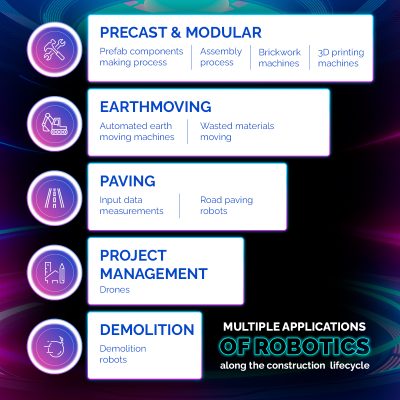We are living in the booming era of construction robots. The global construction robotics market was valued at $168.2 million in 2022 and is expected to reach $774.6 million by 2032. That’s more than a 360% growth in market size in 10 years!
Construction robotics have been around for decades but have only recently experienced a surge in popularity, mainly due to the increasing interest and adoption of robotics in the construction industry after the COVID-19 outbreak in 2020. Wonder why there is so much expected growth surrounding this technology? Read along and discover more!
What is construction robotics?
Construction is still to this day one of the most labor-intensive industries in the world and is grappling with issues related to quality, timelines, safety, and complex environments. According to the European Construction Industry Federation, in 2023, 81% of companies are threatened by the rising prices of materials and energy, and 67% of companies highlighted the shortage of skilled workers in the industry in Germany.
Enter construction robotics!
But how do they work? Robotics is the branch of engineering that integrates computer science with mechanical and electrical engineering. In recent years it has expanded into the construction sector, opening a range of new possibilities.
More concretely, robotic solutions within construction can automate heavy equipment and fleets for excavation, transportation, load lifting, concrete work, and demolition. At the same time, advanced building techniques are also taking advantage of robotics and machine-assisted solutions for activities like waste management, task automation, industrialized construction and 3D printing.

Main advantages of construction robotics
Construction robotics have the potential to significantly revolutionize the industry. Here are some of their primary advantages:
Boost task efficiency
Robots and automated machinery do not experience human symptoms such as fatigue, burnout, or a lack of interest in a repeated process. Therefore, robots can be more efficient in handling repetitive or mundane tasks, since the average human might find them monotonous or may even be prone to making mistakes because of exhaustion and environmental distractions.
That is not to say that robots are perfect; they must be maintained by skilled workers to regularly to provide a consistent quality of work that brings tremendous efficiency to a construction site.
Reduce operating costs
More work in less time calls for less operational costs and associated expenses. Since robots can operate for much longer and at higher levels of precision than human workers, this benefit is intrinsic.
Yet, humans are still needed to program, control, and operate robotic machinery. That’s why there’s a demand for a more highly skilled workforce who can learn to manage these new technologies that are making their way into the mainstream.
Improve health & safety
A more controlled environment means less injuries at a jobsite. The construction industry has long been one of the most dangerous due to the nature of the job: heavy lifting, hazardous elements, and somewhat perilous terrains or platforms. The implementation of construction robots can result in a significant reduction of injuries on construction sites.
Optimize design flexibility
Since the Romans, construction has continuously evolved to reflect changes in the environment and society. Yet, many current construction methods are still carried out the way they were done decades ago. In cases where innovative construction companies like us wish to do things differently, robots are a new friend. They can be programmed or designed to carry out different tasks, giving construction companies the chance to be more creative and efficient with their processes and methods of building.
Promote sustainability
Robotic innovations have helped to usher in an era of sustainable building practices, significantly reducing waste and the environmental impact of construction processes. Robots can optimize resources by accurately measuring and cutting materials, recovering recyclable or valuable items, and extending material lifespan and utility, thus promoting a circular economy.
Additionally, the automation capabilities of robots can lead to faster project completion and lower energy consumption, thereby minimizing the environmental carbon footprint of construction activities.
What types of robots are used in construction and whats tasks do they perform?
Today, robotic systems are undergoing continuous research and development to be able to handle a multitude of tasks. While some are already in use, these versatile machines have widespread applications across the construction value chain, from design to demolition.
Let’s explore three major groups of robots that are building a new horizon in the construction sector.
Stationary robots
These types of robots operate without changing positions. Being “stationary” means that the robot’s base doesn’t move while it is in operation. Within this category, stationary robots can be broken down into gantry robots, robotic arms, and cable robots.
· Gantry robot is an overhead system with a connected manipulator that can move horizontally. In construction, it’s commonly used for pick-and-place operations and welding. One notable advantage is that these robots are less restricted by floor space limitations.
· Robotics arms, also called articulated robots, are the backbone of manufacturing, machinery, and industrial automation. These are the most widespread robots in construction. Their main tasks include welding, handling materials, thermal spraying, painting, drilling, and waste separation process more quickly.
· Cable robots operate with cables and actuators, responsible for carrying out specific actions, such as moving the cables. These robots stand out for their ability to cover large areas while handling hefty loads. Take the CU-Brick for instance, a well-known cable robot in construction that autonomously constructs intricate brick structures using hundreds of bricks or more.
Mobile robots
Mobile robot construction systems provide cutting-edge solutions for accelerating construction. Thanks to their mobility, they can construct structures larger than their size, and their advantages on uneven terrain make them essential for numerous applications. These robots fall into four categories:
· Wheeled mobile robots are user-friendly and cause less surface wear than other solutions. They excel in balance as they are in constant contact with surfaces. A prime example is the autonomous walking excavator Heap, initially deployed for precise excavation of embankments with unique shapes.
· Walking mobile robots offer versatility, efficiency, and the ability to operate on soft and uneven terrain. They provide superior mobility, energy efficiency, stability, and minimal impact on the ground. Additionally, they excel at navigating obstacles or gaps in the environment.
· Flying mobile robots provide a significant advantage in construction by eliminating constraints associated with ground-based movement and the need for scaffolding. These robots float and navigate in the air.
· Swimming mobile robots are not yet prevalent in the AEC industries, but they represent one of the most exciting branches of mobile robotics. An example is OceanOne, which utilizes advanced remotely controlled vehicles and incorporates the advantages of humanoid robots. For instance, it features a robotic hand for retrieving items, mimicking human-like actions.
Swarm robots
Swarm robots enable cooperation and simultaneous task execution, making them a cutting-edge solution. In construction, swarm robots are made up of many small robots to build a design without any guidance.
They follow planned paths to avoid crashing into each other, which keeps construction sites safe by reducing accidents and building impressive structures at a lower cost and risk.

Main solutions
Industrialized construction
Industrialized construction is a hot topic in the construction industry thanks to its advantages related to simplicity, speed, and economy. The global precast housing is expected to reach around $22.9 billion by 2028, growing at an average annual rate of 4.8% from 2023 to 2028.
Nowadays, construction companies are incorporating robotics into industrialized construction, enhancing automated assembly lines and integrating artificial intelligence into supply chains. These tools lead to a higher quality product produced more efficiently. It is necessary to highlight the role of how robots are revolutionizing the industrialized building industry:
- In some “off-site” installations the manufacture of components is automated with the support of robots supervised by workers. Then, in the assembly process, robotic machines automate the assembly of these pieces.
- It is increasingly common to use machines for brickwork, saving time and increasing safety on construction sites.
- Today, 3D printers are one of the main applications of robotics in construction allowing for the manufacture of various materials and structures.
Earthmoving
The initial phase of construction, excavation is inherently prone to numerous unforeseen incidents, primarily concerning worker safety, especially if there are abrupt changes in the condition of the terrain they are working on. Performing earthmoving, the initial excavation or embankment of land before it becomes a job site, demands an investment in both human and material resources.
Advanced construction robotics are key to improving safety in excavation projects by automating clean up and earthmoving tasks or by managing high risk materials.
Paving
Paving involves covering excavated land with various materials in different areas of construction sites. To achieve cost savings and better results, resources need to adapt to the job site conditions. Robotics play a key role in this construction phase, with common uses including data identification through radars, area reading, and 3D modeling. Some robots are even designed specifically for automatically paving roads.
Project management
In the former scenario, drones can play a pivotal role in project management. Numerous companies already leverage drones for diverse tasks, spanning from 3D modeling that provides insights into project landscapes to advanced spatial detection capabilities, drones are reshaping the project management landscape.
Demolition
Finally, construction robotics has generated groundbreaking solutions such as demolition robots. They allow job managers to reduce time and costs because the are able to dismantle structures in record time.

A real example: COBOD
As leaders in the 3D construction printing (3DCP) industry, this Danish startup strives to achieve full automation in the construction industry by designing 3D construction printers and automated processes for building sites.
Together, Cemex and COBOD, (part of our investment portfolio) have worked to convert traditional concrete used in 3D printing into a more versatile aggregate called D.fab that takes shape instantly and is compatible with COBOD’s 3D machinery. COBOD’s mission is to build smarter through multifunctional construction robots based on 3D printing technology.
Cemex Ventures’ contribution to robots in construction
Our approach is simple: we identify the opportunity, and you have a solution that fits said opportunity. You want a partner that will help you propel your business, and we wish to be that partner.
With initiatives like our annual Construction Startup Competition and our mission to search for, invest in, accelerate, and partner with startups that can help us drive the future of the construction industry, we are getting entrepreneurs closer to Cemex and other potential investors who wish to increase the use and adoption of robotics in the construction industry.
“We are looking at all possible solutions, from 3D printing machinery like COBOD’s with whom we can develop the material used to make 3D printed housing, to industrialized construction that can help solve the housing crisis in urban areas,” expressed Gonzalo Galindo, Head of Cemex Ventures.
Does your startup have a robotics solution that can make the industry more agile, innovative, and sustainable? Contact us to discuss how your startup can contribute to a greener future together with Cemex.

